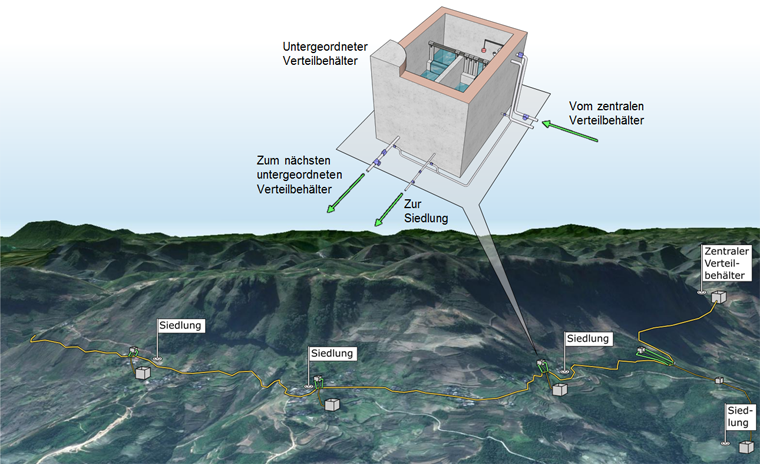Water Distribution

Background
In industrialized nations, water supply usually occurs continuously and to satisfy demand. This means that, at all times and places, sufficient water is made available to the households and/or consumers connected to a distribution system. Sufficient water resources year round and suitable pumping technologies and distribution infrastructure are essential to this. Due to natural and/or climatic constraints on the other hand, developing and emerging countries are often faced with limited water resources. The supply situation is further aggravated by mostly dilapidated infrastructure, thus making it impossible to permanently guarantee the satisfaction of water needs. In order not to further reduce the limited resources through water losses due to leakages in the distribution network, supply usually occurs intermittently. The pipe system is therefore filled with water for a limited period and is not permanently under pressure.
The aforementioned conditions lead to a strongly deficient supply situation in the project region too. Especially during the dry season, there is glaring water shortage and unfair distribution of the limited amount of water due to the heterogeneous settlement structure. To improve the supply situation, the research consortium has already implemented the addition of a hydro-powered water pumping system to the existing Seo Ho Hydroelectric Plant. The amount of water provided by this system is pumped over an altitude difference of 390 m to a central elevated tank, from where Dong Van City is supplied gravitationally with water. Since the distribution system of the district capital, which, hitherto, was principally fed by a karst spring, was operated intermittently and, thus, improperly for many years due to the typical, strong fluctuations in supply, a large part of the existing infrastructure is in very critical condition.
The population in the rural area is also faced with very limited water supply. A major problem here is the unfair distribution of the limited water resources during the months-long dry season due to the heterogeneous settlement structure.

Objective
Therefore, a central aim of the research project is the development and implementation of customized pressure management and rehabilitation concepts to make more efficient supply (extending supply periods, reducing pipe losses through successive replacement of damaged components etc.) possible for the district capital, Dong Van City, even with increasing demand.
Apart from the provision of water, there are also plans for guaranteeing fair distribution through the development and implementation of an innovative distribution concept that takes dynamic fluctuations of supply and demand into account. To achieve this, the quantity of water is distributed using special distribution structures which enable fair distribution of the available supply independent of the location of the users and/or consumers in the supply system. Even with the successful implementation of this innovative distribution concept, due to the fluctuating supply of water, processes of draining and filling the pipes as well as the resulting damage to pipe elements are to be expected. To reliably prevent these processes, an innovative valve shall thus be developed and tested under real operating conditions.
